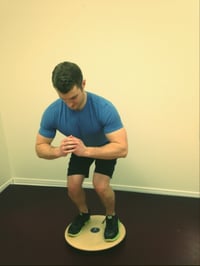
*Ouch*. I bet that one word fully described your life with ankle pain for the past few days? No matter which type of ankle injury you may have - I’m sure you want to get rid of the pain so you can get your freedom back!
To manage discomfort, you've tried following RICE: Rest, Ice, Compression, Elevation. You've even purchased an ankle brace but you're still in pain. Now what? There's tons of research showing that a combination of physiotherapy and exercise stop reoccurring ankle sprains and are effective in managing chronic ankle instability.
I am fortunate enough to be a physiotherapist in Toronto and to be helping patients everyday with their aches & pain. The following 10 exercises are helpful for ankle injuries and can help you start feeling A LOT better.
1. Alphabet
Try writing the alphabet with your injured ankle. Doing this will increase the range of motion of your ankle and when done multiple times a day, will help in a speedy recovery!

2. Calf Stretch
Your calf muscle runs along the backside of your lower leg. When you go further down the leg, this muscle becomes the Achilles Tendon (the tendon located at the back of the ankle). Depending on the ankle injury and the length of time the joint was immobilized, this muscle can become quite tight. To stretch the calf and reverse the effects, stand on a stair with your heel off the edge. Let gravity and your body weight allow your heel to dip below the stairs edge. You should feel a stretch behind your leg. Alternatively, lean against a wall with the ball of your injured leg propped up on the wall. Lean forward and feel the pull in your calf muscle. Hold this for at least 30 seconds and repeat 3 times.

3. Dorsiflexion
While seated, pull your toes upwards, then lower your foot back to the ground. This exercises strengthens the muscles running down the front of your lower leg, and can help increase range of motion. To increase the difficulty of this exercise, use your non-injured foot to resist your injured foot from lifting off the ground. Do this exercises 20 times.

4. Chair Lunges
This exercise aims to increase flexibility in the ankle. Place your injured ankle on a chair. Your knee should be bent, and shift your bodyweight forward so your knee extends over your toes. You should feel the available range of motion in your ankle, then try to push a little bit further as long as there is no pain. Hold the end range for about 30 seconds. Repeat 3 times.

5. One Leg Stance
Balancing on your injured leg will help strengthen the stabilizers of the ankle and will help increase your proprioception. All you have to do is simply stand on your injured leg and balance there for 2 minutes, twice a day. To progress this exercise try closing your eyes, or tossing a ball up in the air, or standing on a pillow/uneven surface.

6. Calf Raises
This exercise is to strengthen the muscles at the back of your leg below your knee. Stand holding onto the back of a chair. Slowly rise up onto your toes, and then lower back to a standing position with feet flat on the floor. Repeat this 20 times. To increase the difficulty of this exercise, you can hold light weights, raise one leg at a time, or perform the exercise on stairs with your heels hanging off the edge (only half your foot on the stair).

7. Resisted Eversion
Use a solid surface as resistance. Against the resistance, try and turn your foot outwards. Hold this for 15 seconds and then relax. Repeat 10 times. This exercise works on the evertors of the ankle.

8. Plantarflexion with Resistence
Put a piece of tubing/Theraband under the ball of your injured foot. Keeping the resistance on, attempt to point your toe. Then return to neutral. Do this exercise 12 times for 3 sets.

9. Wobble Board Squats
To increase proprioception and balance, stand on a wobble board and squat down in a slow and controlled manner. Then return to standing. Repeat this 10 times and do 3 sets. If you do not have access to a wobble board, perform the same movement on a pillow, or try on one leg.

10. Bend and Reach
Stand on your injured leg and slowly reach down to the floor while extending your other leg behind you. You should hinge forward at the hips and bend the supporting knee slightly. Then return to an upright position. Do this 10 times on each leg. To progress this exercise, place objects on the floor around you that you need to touch, or simply hold the position for a few seconds.

Please make sure you check with your physiotherapist before starting these exercises, and don’t do any which increase symptoms or pain! Research has proven that people who seek therapy early after an injury have shorter recovery periods and are 8 times less likely to develop chronic pain.

If you are NOT a Healthcare Professional but have a question? Click here >
Free Shipping
On orders over $250
Learn More>
Get Expert Advice
For Healthcare Professionals only
1-800-561-0310
Contact us >
Technical Support
Does your equipment need
maintenance or calibration?
Contact us >
Finance Your Success
Leasing equipment is simple?
Learn more >
Customer Service Hours: Monday to Friday from 8:00 AM to 5:00 PM EST
Fax: 1-800-561-0349
Mailing Address: 170 Bombardier, Unit 1, Gatineau, QC J8R 0G5